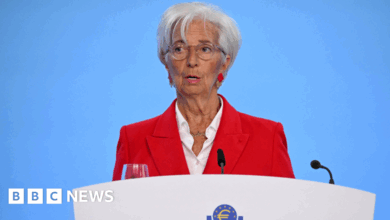Small businesses say they’re pulling back on hiring amid tariff uncertainty

Small business owners across the country are feeling the pinch of tariff-driven cost increases, leading many to rethink their hiring plans. With added expenses on imported inputs and goods, companies are looking for ways to trim costs, including labor expenses. This has resulted in some businesses pressing pause on hiring, cutting workers’ hours, and even laying off staff.
Mike Roach, the owner of Paloma Clothing in Portland, Oregon, is one small business owner who is feeling the impact of these cost increases. He has seen a 22% drop in profit in May compared to the same period last year, leading him to cut down on labor-related spending. While he has not laid off any salespeople yet, he is not hiring and is reducing hours for existing employees.
Shayai Lucero, the owner of Earth & Sky Floral Designs in Albuquerque, New Mexico, had hoped to hire a worker this summer to help with her workload but is now unable to do so due to tariff-related cost increases. Wholesale flower prices have risen so drastically that she has been forced to charge her customers more, reaching a point where she can no longer increase prices without scaring away business.
The National Federation of Independent Businesses (NFIB) May jobs report shows a drop in small business owners planning to create new jobs over the next three months. Labor costs, the top concern for business owners, have also risen, adding to the financial pressure on small businesses.
Small business owners like Ken Giddon, owner of Rothman’s in New York, and Nikki Bravo, owner of Momentum Coffee in Chicago, are among those who have put their hiring plans on hold due to economic uncertainty caused by tariffs. Giddon had planned to add a person or two to his team this year but is now hesitant to do so. Bravo, who typically hires seasonal workers, has had to pull back on that initiative due to increased costs on coffee and packaging materials.
As small businesses continue to navigate the challenges posed by tariffs and rising costs, many are finding it difficult to justify bringing on new employees. The uncertainty in the economic environment has led to a cautious approach to hiring, with many small business owners opting to hold off on expanding their labor forces until there is more clarity and stability in the market. As businesses continue to navigate the uncertain economic landscape, many are faced with the challenge of reducing costs while maintaining stability. In a recent interview, one business owner shared, “So we have to look at other ways to reduce our costs and keep them steady.” This sentiment is echoed by many entrepreneurs who are seeking creative solutions to manage expenses without sacrificing quality or efficiency.
One strategy that businesses are exploring is the adoption of technology to streamline operations and cut down on overhead costs. By investing in software and automation tools, companies can improve productivity and reduce the need for manual labor. This not only helps to lower expenses but also enhances the overall efficiency of the organization.
Another approach that businesses are taking to reduce costs is by renegotiating contracts with suppliers and vendors. By seeking out more favorable terms and pricing agreements, companies can lower their expenses without compromising on the quality of goods and services they receive. This can be a win-win situation for both parties, as it allows businesses to save money while still supporting their partners.
Additionally, businesses are looking at ways to optimize their workforce and maximize employee productivity. By implementing flexible work arrangements, cross-training employees, and incentivizing performance, companies can ensure that they are getting the most out of their workforce while keeping costs in check. This not only helps to reduce expenses but also improves employee morale and retention.
Ultimately, the key to reducing costs and maintaining stability lies in a combination of strategic planning, innovation, and collaboration. By thinking outside the box and exploring new approaches, businesses can find ways to cut costs without sacrificing quality or growth. As the economic landscape continues to evolve, businesses must be willing to adapt and find creative solutions to stay competitive and successful.




